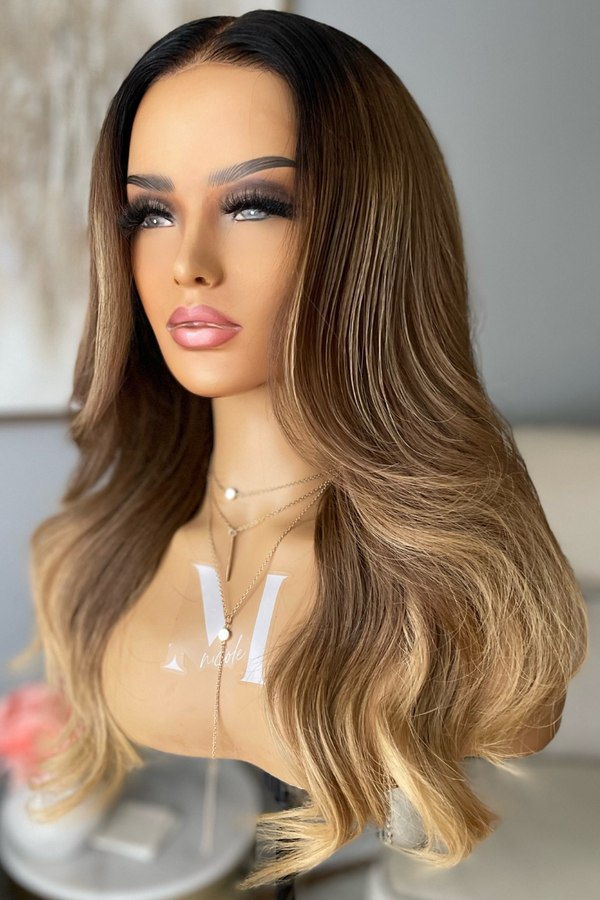5 WAYS TO CARE FOR YOUR HAIR UNDER WIGS & SEW INS


Wearing wigs and sew-ins consistently can have you looking amazing all the time!! BUT… while you’re looking good, your natural hair needs to look and feel healthy as well. You can't put all the energy into taking care of your extensions and not doing the same for your real hair.
Remember: You DO still have to care for your natural hair while it is in your protective style! This includes implementing steps into your natural hair regimen to retain moisture, as well as your length, for the duration of your installation. (For the purpose of this article, natural hair represents hair grown from your scalp, regardless if it has been chemically altered or not.)
1] Wear A Cap Under Your Wig –
Make sure you wear a stocking cap over your natural hair before applying your wig. This can truly be a lifesaver for your natural hair! Placing the wig directly on your hair for an extended period of time WILL cause friction….,this friction will lead to snagging of your hair by the wig. That snagging will cause breakage as well as loss of moisture, and it will wreak havoc on your hair! Let’s be honest, if this is happening then you are defeating the purpose of wearing wigs as a protective style!
In my opinion, there can also be a downside to the caps. Wearing stocking caps at all times can make you more prone to headaches if it’s too tight. One other thing you must stay mindful of is the tension it can cause to your hairline from the elastic/spandex. If all else fails, you can have your stylist sew the perimeter down which will allow you to cut the elastic and still protect your hair!
2] Use A Net:
Another suggestion when having hair sewn in, is to use a weave net to help stabilize the foundation of your braids. I like this because when the braids are not under the net, they are more free to move around, so sewing the net on top of them holds everything together more solidly. Loose, floppy braids don’t support the hair extensions as well as, when they are bound together under the net. This added stabilization also reduces stress on your hair. Another bonus is that the net creates added places to sew the thread through, especially if you are installing extensions on a person with thin hair. Not only does the net provide protection for the natural hair, but it also makes your installation more seamless, allowing it to lay flatter against the scalp.
The downside, it can make it more difficult to scratch your head, as well as being able to clean your scalp when shampooing. To keep your scalp clean and healthy we recommend removing your sew in after about 6 weeks (but definitely no longer than 8) in order to thoroughly clean your scalp.
3] Braid Your Hair Underneath:
Although braiding your hair can be a gruesome task, your natural hair will thank you for it! Braiding is another form of protective styling within itself. Hence, while your hair is being protected from breakage with the wigs and the sew-ins, the natural moisture is being held within the braids. When our natural hair is tucked away, it keeps moisture on our strands, so that you’re not susceptible to any form of damage.
One thing to keep in mind is that if you exercise, and your hair is braided down, it’s in good practice to try and dry your hair completely after your workout! Blow drying it in the back for a few minutes after your workout can alleviate you from having sweaty braids that are left damp. If you choose to leave them damp, please trust me that they WILL start to smell, and you don’t want this! It’s also important to make sure you shampoo your hair weekly. Even if you shampoo while the braids are in, this is still better than not shampooing at all!! ( I learned that trick from one of my clients 😜) After shampooing and conditioning, be sure to sit under a hooded or bonnet dryer so that your hair can completely dry.
4] Use High-Quality Edge Controls:
Now, we all love a good edge control, don’t we? We love having those sleek edges that lasts the entire day and if we are fortunate on over into the evening! But please keep this in mind, ladies: Certain gels are manufactured with drying alcohol. This shortcut is cheaper for the manufacturers, but is at the expense of our beautiful hair. So, to keep our edges healthy, it is important to invest in a high-quality edge control!
Try choosing an edge control with natural oils, butter and gels because of the minerals embedded in it. It will nourish your edges while slaying them at the same time! Regardless of the edge control you decide to use, tying your edges down when around the house or before bed will help to train them to lay down. And, if you have curlier hair, this is ESPECIALLY helpful!!
5] Let Your Natural Hair Breathe:
Last, but probably most important, is the necessity to let your hair breathe!! If you are not wearing a wig that can be removed at night, then you definitely need to periodically take your hair down and give it a rest. When you take off your wigs at night, it gives your body the same feeling as taking off your shoes at the end of the day… And I am CERTAIN we are all familiar with how amazing that feels!! So, in the same way, you have to give your scalp much needed oxygen to allow proper blood circulation in order for your mane to flourish. This also allows a chance for you to oil and manipulate your scalp, as needed.
This is also the time you can allow your edges to be completely free of tension! So please ladies…. BE KIND TO YOUR HAIR!! It’s the only head of hair you’re ever going to have! And you can’t keep your hair hidden away forever! So, every now and then, just give it a break! Whether you take it off every night, or take a week off between your installations, remember to be kind to your hair (especially those edges!)
Your hair is your crown, give it the utmost care that it needs to thrive while protected!
How do you care for your hair under wigs and sew-ins?






